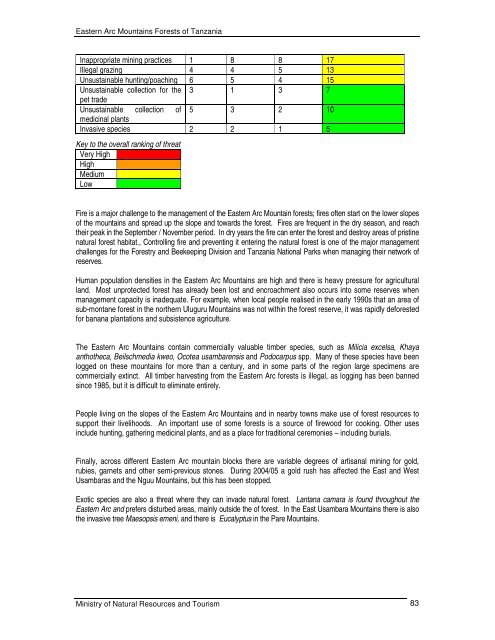eastern arc mountains forests of tanzania - Campaign for the ...
eastern arc mountains forests of tanzania - Campaign for the ...
eastern arc mountains forests of tanzania - Campaign for the ...
You also want an ePaper? Increase the reach of your titles
YUMPU automatically turns print PDFs into web optimized ePapers that Google loves.
Eastern Arc Mountains Forests <strong>of</strong> Tanzania<br />
Inappropriate mining practices 1 8 8 17<br />
Illegal grazing 4 4 5 13<br />
Unsustainable hunting/poaching 6 5 4 15<br />
Unsustainable collection <strong>for</strong> <strong>the</strong><br />
pet trade<br />
3 1 3 7<br />
Unsustainable<br />
medicinal plants<br />
collection <strong>of</strong> 5 3 2 10<br />
Invasive species 2 2 1 5<br />
Key to <strong>the</strong> overall ranking <strong>of</strong> threat<br />
Very High<br />
High<br />
Medium<br />
Low<br />
Fire is a major challenge to <strong>the</strong> management <strong>of</strong> <strong>the</strong> Eastern Arc Mountain <strong><strong>for</strong>ests</strong>; fires <strong>of</strong>ten start on <strong>the</strong> lower slopes<br />
<strong>of</strong> <strong>the</strong> <strong>mountains</strong> and spread up <strong>the</strong> slope and towards <strong>the</strong> <strong>for</strong>est. Fires are frequent in <strong>the</strong> dry season, and reach<br />
<strong>the</strong>ir peak in <strong>the</strong> September / November period. In dry years <strong>the</strong> fire can enter <strong>the</strong> <strong>for</strong>est and destroy areas <strong>of</strong> pristine<br />
natural <strong>for</strong>est habitat., Controlling fire and preventing it entering <strong>the</strong> natural <strong>for</strong>est is one <strong>of</strong> <strong>the</strong> major management<br />
challenges <strong>for</strong> <strong>the</strong> Forestry and Beekeeping Division and Tanzania National Parks when managing <strong>the</strong>ir network <strong>of</strong><br />
reserves.<br />
Human population densities in <strong>the</strong> Eastern Arc Mountains are high and <strong>the</strong>re is heavy pressure <strong>for</strong> agricultural<br />
land. Most unprotected <strong>for</strong>est has already been lost and encroachment also occurs into some reserves when<br />
management capacity is inadequate. For example, when local people realised in <strong>the</strong> early 1990s that an area <strong>of</strong><br />
sub-montane <strong>for</strong>est in <strong>the</strong> nor<strong>the</strong>rn Uluguru Mountains was not within <strong>the</strong> <strong>for</strong>est reserve, it was rapidly de<strong>for</strong>ested<br />
<strong>for</strong> banana plantations and subsistence agriculture.<br />
The Eastern Arc Mountains contain commercially valuable timber species, such as Milicia excelsa, Khaya<br />
antho<strong>the</strong>ca, Beilschmedia kweo, Ocotea usambarensis and Podocarpus spp. Many <strong>of</strong> <strong>the</strong>se species have been<br />
logged on <strong>the</strong>se <strong>mountains</strong> <strong>for</strong> more than a century, and in some parts <strong>of</strong> <strong>the</strong> region large specimens are<br />
commercially extinct. All timber harvesting from <strong>the</strong> Eastern Arc <strong><strong>for</strong>ests</strong> is illegal, as logging has been banned<br />
since 1985, but it is difficult to eliminate entirely.<br />
People living on <strong>the</strong> slopes <strong>of</strong> <strong>the</strong> Eastern Arc Mountains and in nearby towns make use <strong>of</strong> <strong>for</strong>est resources to<br />
support <strong>the</strong>ir livelihoods. An important use <strong>of</strong> some <strong><strong>for</strong>ests</strong> is a source <strong>of</strong> firewood <strong>for</strong> cooking. O<strong>the</strong>r uses<br />
include hunting, ga<strong>the</strong>ring medicinal plants, and as a place <strong>for</strong> traditional ceremonies – including burials.<br />
Finally, across different Eastern Arc mountain blocks <strong>the</strong>re are variable degrees <strong>of</strong> artisanal mining <strong>for</strong> gold,<br />
rubies, garnets and o<strong>the</strong>r semi-previous stones. During 2004/05 a gold rush has affected <strong>the</strong> East and West<br />
Usambaras and <strong>the</strong> Nguu Mountains, but this has been stopped.<br />
Exotic species are also a threat where <strong>the</strong>y can invade natural <strong>for</strong>est. Lantana camara is found throughout <strong>the</strong><br />
Eastern Arc and prefers disturbed areas, mainly outside <strong>the</strong> <strong>of</strong> <strong>for</strong>est. In <strong>the</strong> East Usambara Mountains <strong>the</strong>re is also<br />
<strong>the</strong> invasive tree Maesopsis emeni, and <strong>the</strong>re is Eucalyptus in <strong>the</strong> Pare Mountains.<br />
Ministry <strong>of</strong> Natural Resources and Tourism 83


